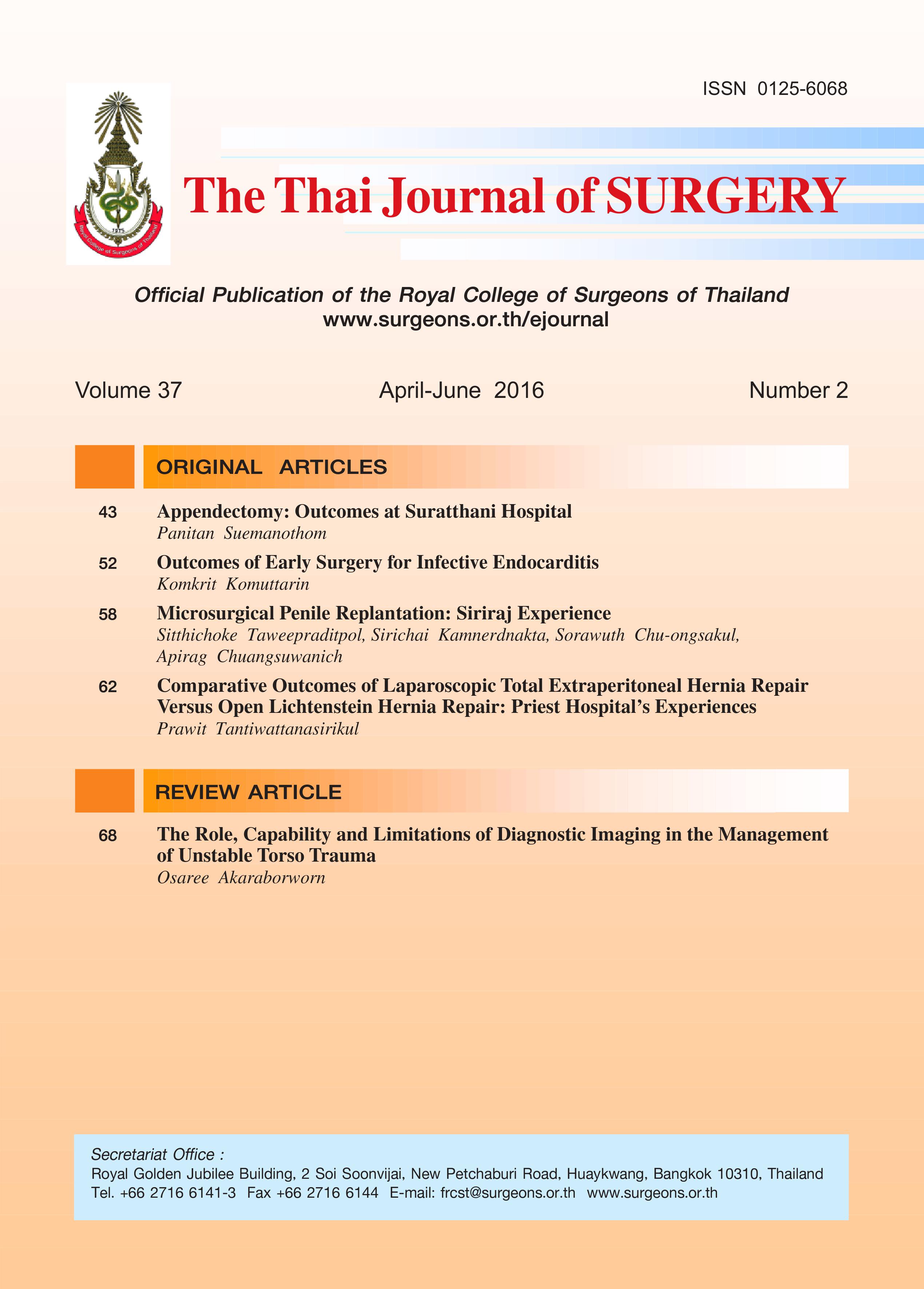The Role, Capability and Limitations of Diagnostic Imaging in the Management of Unstable Torso Trauma
Keywords:
Multiple trauma, multimodal imaging, abdominal injuriesAbstract
Diagnostic imaging has been recognized as a useful tool for management in stable trauma patients and it is believed that it has limitation for unstable patients. This article is an evidence based review on the role of diagnostic imaging in unstable torso trauma. Focused Assessment with Sonography for Trauma(FAST) has a great role for diagnostic hemorrhage in blunt abdominal trauma and blood in pericardial stab wounds. Extended-FAST(EFAST) has a promising role for diagnostic pneumothorax and hemothorax and is also useful to confirm the positions after placement of tubes and lines. A CT scan has limited role in unstable patients; however, there are reports that a CT scan can be used to identify sources of bleeding in selected situations. Diagnostic imaging has both capability and limitation in unstable torso trauma. Patient selections for each modality enhance accuracy for the imaging.
References
2. Fleming S, Bird R, Ratnasingham K, Sarker S-J, Walsh M, Patel B. Accuracy of FAST scan in blunt abdominal trauma in a major London trauma centre. Int J Surg 2012;10(9):470-4.
3. Becker A, Lin G, McKenney MG, Marttos A, Schulman CI. Is the FAST exam reliable in severely injured patients? Injury. 2010;41(5):479-83.
4. Wherrett LJ, Boulanger BR, McLellan BA, Brenneman FD, Rizoli SB, Culhane J, et al. Hypotension after blunt abdominal trauma: the role of emergent abdominal sonography in surgical triage. J Trauma 1996;41(5):815-20.
5. Friese RS, Malekzadeh S, Shafi S, Gentilello LM, Starr A. Abdominal ultrasound is an unreliable modality for the detection of hemoperitoneum in patients with pelvic fracture. J Trauma 2007;63(1):97-102.
6. Rozycki GS, Ballard RB, Feliciano DV, Schmidt JA, Pennington SD. Surgeon-performed ultrasound for the assessment of truncal injuries: lessons learned from 1540 patients. Ann. Surg 1998;228(4):557-67.
7. Holmes JF, Harris D, Battistella FD. Performance of abdominal ultrasonography in blunt trauma patients with out-of-hospital or emergency department hypotension. Ann Emerg Med. 2004;43(3):354-61.
8. Biffl WL, Kaups KL, Pham TN, Rowell SE, Jurkovich GJ, Burlew CC, et al. Validating the Western Trauma Association Algorithm for Managing Patients With Anterior Abdominal Stab Wounds: A Western Trauma Association Multicenter Trial. The Journal of Trauma: Injury, Infection, and Critical Care 2011;71(6):1494-502.
9. Ball CG, Williams BH, Wyrzykowski AD, Nicholas JM, Rozycki GS, Feliciano DV. A caveat to the performance of pericardial ultrasound in patients with penetrating cardiac wounds. J Trauma 2009;67(5):1123-4.
10. Rozycki GS, Feliciano DV, Ochsner MG, Knudson MM, Hoyt DB, Davis F, et al. The role of ultrasound in patients with possible penetrating cardiac wounds: a prospective multicenter study. J Trauma 1999;46(4):543-551;discussion 551-552.
11. Meyer DM, Jessen ME, Grayburn PA. Use of echocardiography to detect occult cardiac injury after penetrating thoracic trauma: a prospective study. J Trauma. 1995;39(5):902-907;discussion 907-909.
12. Matsushima K, Frankel HL. Beyond focused assessment with sonography for trauma. Current Opinion in Critical Care 2011;17(6):606-12.
13. Nandipati KC, Allamaneni S, Kakarla R, Wong A, Richards N, Satterfield J, et al. Extended focused assessment with sonography for trauma (EFAST) in the diagnosis of pneumothorax: experience at a community based level I trauma center. Injury 2011;42(5):511-4.
14. Ultrasound to detect haemothorax after chest injury. Emerg Med J 2007;24(8):581-2.
15. Duane TM, Tan BB, Golay D, Cole FJ Jr, Weireter LJ Jr, Britt LD. Blunt trauma and the role of routine pelvic radiographs: a prospective analysis. J Trauma 2002;53(3):463-8.
16. Guillamondegui OD, Pryor JP, Gracias VH, Gupta R, Reilly PM, Schwab CW. Pelvic radiography in blunt trauma resuscitation: a diminishing role. J Trauma 2002;53(6):1043-7.
17. Charani H, Wisborg T, Hansen KS, Brattebφ G, Stenseth LB. Clinical examination of the pelvis in patients with multiple traumas is unreliable. Tidsskr Nor Laegeforen 2003;123 (20):2881-3.
18. Gillman LM, Ball CG, Panebianco N, Al-Kadi A, Kirkpatrick AW. Clinician performed resuscitative ultrasonography for the initial evaluation and resuscitation of trauma. Scand J Trauma Resusc Emerg Med 2009;17:34.
19. Schuster KM, Lofthouse R, Moore C, Lui F, Kaplan LJ, Davis KA. Pulseless electrical activity, focused abdominal sonography for trauma, and cardiac contractile activity as predictors of survival after trauma. J Trauma 2009 ;67(6):1154-7.
20. Saglam C, Unlüer EE, Karagöz A. Confirmation of endotracheal tube position during resuscitation by bedside ultrasonography. Am J Emerg Med 2013;31(1):248-50.
21. Werner SL, Smith CE, Goldstein JR, Jones RA, Cydulka RK. Pilot study to evaluate the accuracy of ultrasonography in confirming endotracheal tube placement. Ann Emerg Med 2007;49(1):75-80.
22. Fu C-Y, Hsieh C-H, Shih C-H, Wang Y-C, Chen R-J, Huang HC, et al. Selective Computed Tomography and Angioembolization Provide Benefits in the Management of Patients with Concomitant Unstable Hemodynamics and Negative Sonography Results. World J Surg 2012;36(4):819-25.
Downloads
Published
How to Cite
Issue
Section
License
Articles must be contributed solely to The Thai Journal of Surgery and when published become the property of the Royal College of Surgeons of Thailand. The Royal College of Surgeons of Thailand reserves copyright on all published materials and such materials may not be reproduced in any form without the written permission.



